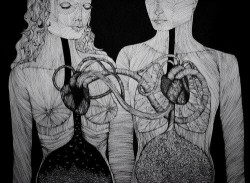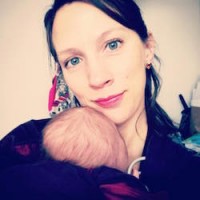There’s a lump in the back of her throat, right at the base of her neck—but the tears won’t stream for her.
She’s slightly nauseous, but it’s not the baby growing inside of her.
She feels agitated—annoyed at the whole world.
Her mouth is set in a firm, straight line and her wrinkled brow, she’s sure, is deepening the two, feathered lines just above the bridge of her nose.
She’s always been a serious girl, but she’s always been a playful one too.
She has vivid recollections of lying outside as a young child in the heat of an Ohio summer, grass stuck to the backs of her sweaty thighs, thinking about how she wants to grow up—really she does—to be taken more seriously, but how, equally, she isn’t ready to leave the lazy, irresponsibility of childhood behind.
She noticed the way adults around her owned houses and drove cars, and she could barely fathom how one matures enough to do all of these things and still be able to live.
Her fingers move at a slow, steady pace across her laptop keyboard and she feels her long-awaited tears prick the backs of her eyes.
Now, however—finally here—she chokes them back, in order to better see her computer screen, but she still feels water cloud her eyes at their inner creases.
She hears the chimes of giggles and the corresponding thumps and thuds and grunts of a small daughter playing with her father, while she sits separately from them, cozily underneath her quilt of light blue; pillows propping her up in bed; her laptop perched atop her legs.
The tears recede as quickly as they arrived and she swallows to notice how the lump within her neck has reacted to this short, salty visit—it’s still there, she observes, but its edges are less jagged and pointy.
Her agitation has also softened. She finds it remarkable how healing tears can be.
She’s perhaps more fascinated by the little child left in all of us that occasionally wants to tantrum and storm about and howl for no authentically good enough reason, the one who wants to be loved and who wants to simply feel her way through life, rather than always following the logical order of the grown-up world.
At this confession, the tears come back and her foggy throat thickens.
She’s personally acknowledged the many, long-gone days that her little girl self sat outside among the grass, wondering how on earth she’ll ever be able to grow up, but, regardless, her current matronly tears—wanting so badly to slide down her cheeks—instead collect in tiny ponds beneath her lower lashes.
She listens for the sound of her own little girl as she roughhouses, immersed in important childhood play.
Her nose is slightly runny and her heart has a tender ache, right at the back, just below the lump in her throat.
Most days she’s able to convincingly play the part of adult woman, but some days she desires so much to not be so responsible for herself—for her emotions and her reactions and her overall fails at adulthood.
At that, the tears rush freely down her cheeks; sitting on her chin before rolling down and drop, drop, dropping on the red, heathered shirt that covers her expectant mother’s breast.
She sniffs and blinks and the black letters on her white background have a hazy, haloed effect.
Because the big-girl world can be quite a disappointment.
People let her down and she lets others down too—people she deeply cares about and who, more than anything, she doesn’t want to hurt.
And the big-girl world is full of good-byes and some are permanent and no good-bye is enough, and there are true trials and deep, scar-forming pains that occur, no matter how hard you try to avoid knee scrapes and broken bones.
The worst wounds are invisible—she learned that before she was yet a woman.
The hardest falls to return to standing from are ironically those that the outside world can barely see, much less touch.
Her tears subside once again and she reaches for a white handkerchief, lined with crocheted lace from her great-grandmother’s hands.
She pauses. She scratches her forehead and feels the slight burn around her eyes from where the salt of her own tears sat, and it dawns on her that she is a woman—she’s not playing dress-up and fooling the eyes around her—but, at the same time, she’s still a child, and she’ll always be that, whether or not she or anyone else admits it.
Because the best parts of us don’t grow up at all—that small space that shrieks with laughter at inopportune times; the intuition that comes in waves and flashes; our cravings for love and for joy in their most basic, human forms.
She hears her little girl sing loudly outside the thin, bedroom door, and she’s reminded of the unaffected magic that exists in her life.
With the lump in her throat gone and her brief salty storm passed, she feels her heart become steady, back into the quiet, soothing pace of her womanly chest, and she knows that it’s our emotions that connect us all—young and old, girl and woman, boy and man—it’s here, in our internal spaces of irrationality that life becomes truly tangible and worthwhile and whole.
It’s our innocence and our fragility, and our tears and our shouts and our once-baby whispers that connect us, and remembering this—always—well, that’s how to connect two human hearts.
Love elephant and want to go steady?
Sign up for our (curated) daily and weekly newsletters!
Editor: Renée Picard
Photo: elephant archives












Read 0 comments and reply